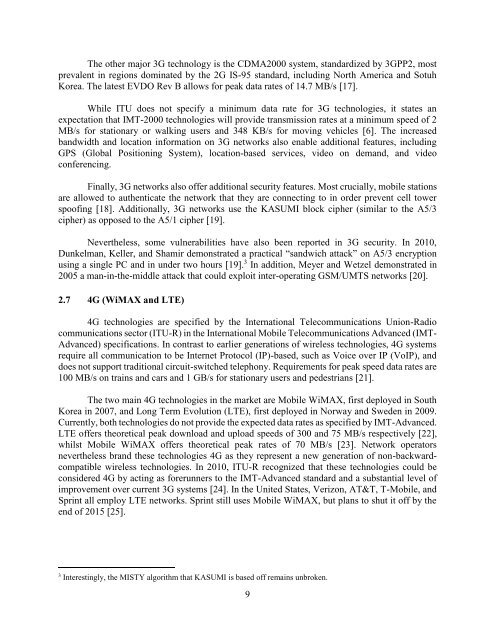IMSI Catchers and Mobile Security
EAS499Honors-IMSICatchersandMobileSecurity-V18F-1
EAS499Honors-IMSICatchersandMobileSecurity-V18F-1
You also want an ePaper? Increase the reach of your titles
YUMPU automatically turns print PDFs into web optimized ePapers that Google loves.
The other major 3G technology is the CDMA2000 system, st<strong>and</strong>ardized by 3GPP2, most<br />
prevalent in regions dominated by the 2G IS-95 st<strong>and</strong>ard, including North America <strong>and</strong> Sotuh<br />
Korea. The latest EVDO Rev B allows for peak data rates of 14.7 MB/s [17].<br />
While ITU does not specify a minimum data rate for 3G technologies, it states an<br />
expectation that IMT-2000 technologies will provide transmission rates at a minimum speed of 2<br />
MB/s for stationary or walking users <strong>and</strong> 348 KB/s for moving vehicles [6]. The increased<br />
b<strong>and</strong>width <strong>and</strong> location information on 3G networks also enable additional features, including<br />
GPS (Global Positioning System), location-based services, video on dem<strong>and</strong>, <strong>and</strong> video<br />
conferencing.<br />
Finally, 3G networks also offer additional security features. Most crucially, mobile stations<br />
are allowed to authenticate the network that they are connecting to in order prevent cell tower<br />
spoofing [18]. Additionally, 3G networks use the KASUMI block cipher (similar to the A5/3<br />
cipher) as opposed to the A5/1 cipher [19].<br />
Nevertheless, some vulnerabilities have also been reported in 3G security. In 2010,<br />
Dunkelman, Keller, <strong>and</strong> Shamir demonstrated a practical “s<strong>and</strong>wich attack” on A5/3 encryption<br />
using a single PC <strong>and</strong> in under two hours [19]. 3 In addition, Meyer <strong>and</strong> Wetzel demonstrated in<br />
2005 a man-in-the-middle attack that could exploit inter-operating GSM/UMTS networks [20].<br />
2.7 4G (WiMAX <strong>and</strong> LTE)<br />
4G technologies are specified by the International Telecommunications Union-Radio<br />
communications sector (ITU-R) in the International <strong>Mobile</strong> Telecommunications Advanced (IMT-<br />
Advanced) specifications. In contrast to earlier generations of wireless technologies, 4G systems<br />
require all communication to be Internet Protocol (IP)-based, such as Voice over IP (VoIP), <strong>and</strong><br />
does not support traditional circuit-switched telephony. Requirements for peak speed data rates are<br />
100 MB/s on trains <strong>and</strong> cars <strong>and</strong> 1 GB/s for stationary users <strong>and</strong> pedestrians [21].<br />
The two main 4G technologies in the market are <strong>Mobile</strong> WiMAX, first deployed in South<br />
Korea in 2007, <strong>and</strong> Long Term Evolution (LTE), first deployed in Norway <strong>and</strong> Sweden in 2009.<br />
Currently, both technologies do not provide the expected data rates as specified by IMT-Advanced.<br />
LTE offers theoretical peak download <strong>and</strong> upload speeds of 300 <strong>and</strong> 75 MB/s respectively [22],<br />
whilst <strong>Mobile</strong> WiMAX offers theoretical peak rates of 70 MB/s [23]. Network operators<br />
nevertheless br<strong>and</strong> these technologies 4G as they represent a new generation of non-backwardcompatible<br />
wireless technologies. In 2010, ITU-R recognized that these technologies could be<br />
considered 4G by acting as forerunners to the IMT-Advanced st<strong>and</strong>ard <strong>and</strong> a substantial level of<br />
improvement over current 3G systems [24]. In the United States, Verizon, AT&T, T-<strong>Mobile</strong>, <strong>and</strong><br />
Sprint all employ LTE networks. Sprint still uses <strong>Mobile</strong> WiMAX, but plans to shut it off by the<br />
end of 2015 [25].<br />
3<br />
Interestingly, the MISTY algorithm that KASUMI is based off remains unbroken.<br />
9



